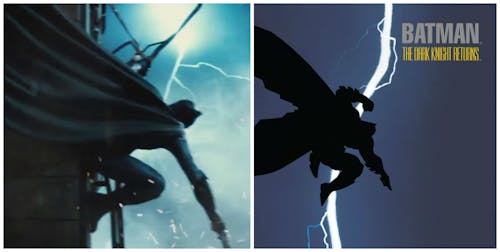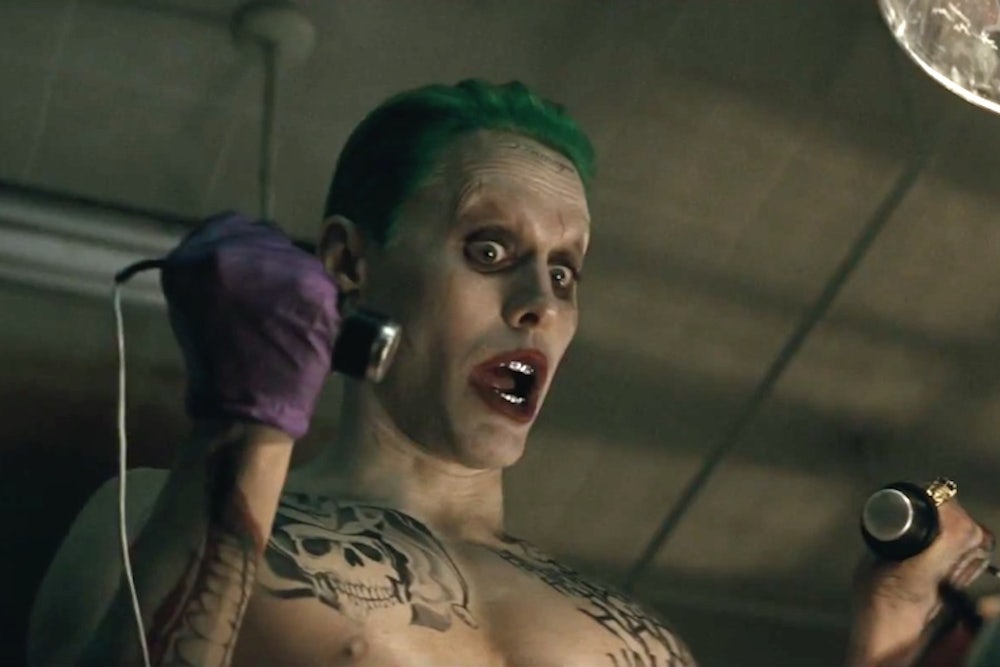Over the weekend at Comic-Con in San Diego, DC Comics and Warner Brothers released trailers for two superhero movies slated for released next year. Batman v Superman: Dawn of Justice appears to be a political parable: It deliberately alludes to such national traumas as 9/11 and the flooding of New Orleans by Hurricane Katrina, and Superman is denounced by protesters as an "illegal alien." Suicide Squad, meanwhile, features highly sexualized violence—a woman is strapped down by a leather belt in her mouth—and torture. "Oh, I’m not going to kill you," The Joker, played by Jared Leto, says to one victim. "I’m just going to hurt you really, really bad."
Both movies appear as dark and grim—both visually and thematically—as other superhero films of late, such as Christopher Nolan's Dark Knight trilogy, Zack Synder’s Man of Steel, James Mangold’s The Wolverine, and Matthew Vaughn’s Kick-Ass, among many others. Kick-Ass was rated R, and most of the others were aimed at an adult-only audience. Like these movies, TV series such as "Daredevil" and "Arrow" have also been saturated with bone-crunching violence. The proliferation of such mature superhero adaptations reflects a three decades-old trend in the comic book industry, which is now so entrenched that the brighter, family-friendly adaptations—last year's Guardians of the Galaxy and, out this week, Ant-Man—are the exceptions. The superhero genre was originally created as all ages entertainment, aimed mainly at kids but sometimes done in a manner that allowed adults to enjoy them as well. So isn’t it odd that the dominant mode of the genre is now so skewed towards an adult audience? And is this really the best use of the genre?
Superheroes were not meant to be exclusively for adults. The comic books that introduced them were originally marketed to children, and in some cases were created by artists who were barely adults. Cartoonists Jerry Siegel and Joe Shuster first fleshed out the idea for Superman in 1933, when they were both 19 years old. In 1940, as the 18-year-old assistant to Batman creator Bob Kane, Jerry Robinson helped give birth to the Joker. Superheroes were increasingly marketed to adults as well, but rarely exclusively so. Through the mid-1980s, almost all superhero comics were all-ages entertainment. Some were aimed specifically at young children, while others were more sophisticated, but they all were geared to an audience where children were at least potential readers.
The best of these comics—Jack Cole’s Plastic Man, Will Eisner’s The Spirit, the 1960s Marvel comics created by Stan Lee, Jack Kirby, and Steve Ditko—worked in the same multi-layered way of literary works like Treasure Island, The Adventures of Huckleberry Finn or the Little Women series. They were frothy, fun and light-hearted in a way that engaged the imagination of children, but had enough layers of meaning to also reward adult readers. The same was true of most live-action adaptations, like the 1960s Batman TV show starring Adam West and Christopher Reeve's Superman of the 1970s and '80s (and their bright colors contrast starkly with the muddy palette of Batman v Superman and Suicide Squad, where the sky is perpetually overcast, if not raining).

So what changed? Starting in the 1980s, an influential group of comic book creators, led by Frank Miller and Alan Moore, broke from this tradition and crafted superhero stories that were geared toward an exclusively adult audience. Miller and Moore are often credited with helping the superhero genre grow up, although their idea of maturity at times seemed mainly to mean including explicit scenes of torture and rape. Miller’s pathbreaking graphic novel The Dark Knight Returns (1986) featured an aged Batman coming out of retirement and forming a vigilante group in a decadent future America. Alan Moore’s and Dave Gibbons’s Watchmen (1986) deconstructed the superhero genre by portraying the bitter back-biting of a group of flawed vigilante’s set against the cheerless background of an imminent nuclear war. The work of Miller and Moore has been immensely successful commercially and has re-shaped the superhero genre. And aesthetically, Miller’s flamboyant expressionism and Moore’s intricate clock-work story-telling have left their mark. Yet by following the lead of Miller and Moore, the genre made a fundamentally wrong turn, and now has lost touch with its best tendencies.
Superheroes work best as all ages entertainment because the roots of the genre are in the children’s daydreams: to be able to fly like Superman, to wield a lasso like Wonder Woman, to run like the Flash, or to leap from building to building like Spider-Man. A good all-ages superhero story works to satisfy the core desire that these emblematic heroes embody, while also providing a narrative hook that allows adult readers to enter into the innocence of a fantasy world. Superhero stories aimed at adults almost invariably suffer a bad conscience about the roots of the genre in childhood, so they go out of their way to establish their grown-up bona fides by emphasizing grotesque violence and lurid sexuality. As the cartoonist Chris Ware wrote in an email to me, “Writing serious stories about superheroes for adults is like writing pornography for children."
As Ware suggests, there is something inherent in the genre that works against aiming for an adult-only audience, as Batman v Superman does. The very idea of constructing a story where Batman fights Superman only works on the level of child’s logic: Batman is supposed to be no more than a physically fit human, while Superman is an alien with God-like powers. The only reason to join them together is to please the same child’s sensibility that you see in playgrounds, where dinosaurs do battle with GI Joe or where Mr. Potato Head has tea with Cinderella. So it seems absurd to imbue a story about Batman duking it out with Superman with psychological verisimilitude, as the trailer does.
Even the creators most responsible for this turn towards gritty, angst-filled superheroes are aware of the shakiness of their position. “By and large, pulp comics make their money selling to children and children are generally much more innocent than older people," Miller said in a 1985 interview with The Comics Journal. "I’d be very careful about what was in children’s stories, I’d be much more careful than they are at Marvel or DC…. I’m uncomfortable with the idea of children seeing stories where women are dressed in B&D costumes, and where rather annoying cloy little sex references are made pretty continuously.”
The following year, Miller wrote the series Batman: Year One, which featured the caped crusader’s foil Catwoman as a dominatrix. Miller became upset when Jenette Kahn, the publisher of DC Comics, asked him to remove a scene showing Catwoman grasping a whip. Asked in 1986 by The Comics Journal to reconcile his earlier statement that he didn’t want children to see women dressed in B&D costumes with his portrayal of Catwoman, Miller admitted there was a “contradiction.”
In the same interview, Miller said, “I don’t really write for children.” There’s nothing wrong, of course, with not wanting to write stories for children. But in that case, Miller should stop writing superhero stories altogether.
